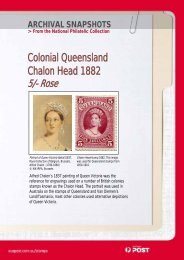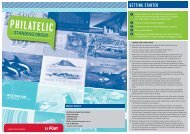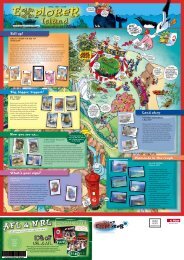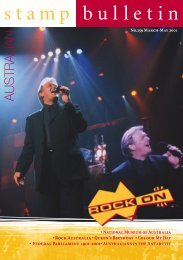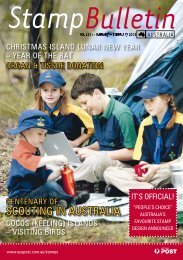stamp bulletin - Australia Post Shop
stamp bulletin - Australia Post Shop
stamp bulletin - Australia Post Shop
You also want an ePaper? Increase the reach of your titles
YUMPU automatically turns print PDFs into web optimized ePapers that Google loves.
253 <strong>bulletin</strong><br />
In this Bulletin...<br />
Face of <strong>Australia</strong> 3<br />
CI Lunar New Year 8<br />
<strong>Australia</strong>n Legends 10<br />
Arts Festivals 11<br />
<strong>Australia</strong> <strong>Post</strong> <strong>stamp</strong> designs and philatelic<br />
products are subject to copyright and may<br />
not be reproduced without permission. All<br />
applications for the reproduction of <strong>Australia</strong>n<br />
<strong>stamp</strong>s should be made in writing to:<br />
The Manager – Philatelic Group<br />
<strong>Australia</strong> <strong>Post</strong><br />
GPO Box 1777Q<br />
MELBOURNE VIC 3001<br />
Fax: 03 9204 7744<br />
The <strong>Australia</strong>n Stamp Bulletin is produced by<br />
the <strong>Australia</strong> <strong>Post</strong> Philatelic Group and printed<br />
by Canberra Press Moorabbin.<br />
All information contained in this Bulletin has<br />
been included in good faith, on the basis that<br />
the products will be available for sale, until<br />
stock sold out, at the prices stated, and in the<br />
manner described.<br />
To the best of <strong>Australia</strong> <strong>Post</strong>’s knowledge,<br />
all information contained in this Bulletin was<br />
correct at the time of printing. <strong>Australia</strong> <strong>Post</strong><br />
will not, however, be held responsible for any<br />
inadvertent errors or oversights, or any change<br />
to information which may occur after publication.<br />
Cover: Stacy Coull, Northern Territory<br />
(Photograph - Kathy Roberts)<br />
Find out more about <strong>stamp</strong>s by<br />
visiting <strong>Australia</strong> <strong>Post</strong>’s web site:<br />
www.auspost.com.au/<strong>stamp</strong>s<br />
2<br />
Dear Collectors,<br />
The year 2000 is a time of national celebration and two of<br />
our January issues seek to capture and promulgate the spirit of<br />
our nation.<br />
We at <strong>Australia</strong> <strong>Post</strong> aim to reflect the spirit of our nation in<br />
our annual <strong>stamp</strong> issue programme. But that is sometimes easier<br />
said than done. The concept of our national spirit is somewhat<br />
elusive, sometimes controversial and always evolving.<br />
<strong>Australia</strong> covers a huge area and our population has a diverse<br />
range of backgrounds. Our national spirit is as wide and varied<br />
as our land and the peoples that inhabit it. Nevertheless, our<br />
January issues, Face of <strong>Australia</strong> and <strong>Australia</strong>n Legends, capture<br />
the spirit of <strong>Australia</strong> in a readily identifiable and uniquely<br />
<strong>Australia</strong>n way. I am proud to be associated with them and I<br />
hope you will share my pride in the values and sentiments these<br />
<strong>stamp</strong> issues represent.<br />
In a formal sense the Face of <strong>Australia</strong> issue (on 1 January)<br />
is <strong>Australia</strong> <strong>Post</strong>'s celebration of the year 2000. Other nations<br />
are celebrating 2000 philatelically by issuing historical series<br />
covering the last 100 or 1000 years; others are using special<br />
features such as limited editions or gold foil. Our approach was<br />
to celebrate our greatest national asset, the people of <strong>Australia</strong>.<br />
The Face of <strong>Australia</strong> issue presents a cross section of our<br />
nation; young and old, male and female, city and rural, old and<br />
new arrivals. It is a time capsule of <strong>Australia</strong>ns in the year 2000.<br />
This issue gives us a glimpse of our past, our present and our<br />
future. The people whose faces appear on the <strong>stamp</strong>s are not<br />
being honoured as individuals. They were chosen to represent<br />
all of us, and in that way this <strong>stamp</strong> issue honours all of us.<br />
Yes, it is a large <strong>stamp</strong> issue but necessarily so, in order to<br />
represent effectively a cross section of our community. The year<br />
2000 is a special time warranting a special form of commemoration.<br />
Our second January issue, for <strong>Australia</strong> Day, will also stir<br />
the national spirit. As in past years, the subject of this issue is a<br />
closely guarded secret. Until it is released, all I can say is that the<br />
<strong>Australia</strong>n Legends issue for the year 2000 is destined to touch<br />
the heart, spirit and national pride of every <strong>Australia</strong>n.<br />
Until next time,<br />
David Maiden,<br />
Manager, Philatelic Group<br />
Face of <strong>Australia</strong> 1 January 2000<br />
To celebrate the beginning of the year 2000,<br />
<strong>Australia</strong> <strong>Post</strong> is issuing a sheetlet of 25 <strong>stamp</strong>s.<br />
Each <strong>stamp</strong> features a photograph of an<br />
<strong>Australia</strong>n resident. As a group the <strong>stamp</strong>s give<br />
us a snapshot of the nation at this moment in<br />
our history.<br />
<strong>Australia</strong> in the year 2000<br />
As we begin the year our estimated population<br />
exceeds 19 million, almost five times the size<br />
of the population at the time of Federation.<br />
The most populous State is New South Wales,<br />
followed by Victoria, Queensland, Western<br />
<strong>Australia</strong>, South <strong>Australia</strong> and Tasmania. In<br />
1911, 43 percent of <strong>Australia</strong>ns lived in rural<br />
areas. Through the century this percentage has<br />
dropped to its current level of about 14 per cent.<br />
Despite this, the image of our rural identity<br />
remains strong.<br />
The tendency for <strong>Australia</strong>ns to have fewer<br />
children, along with an increased life expectancy,<br />
has contributed to an ageing population. In 1971<br />
the median age was 27.5 years, in 1991 it was 32.5<br />
and in 1996, 34 years. Throughout the years,<br />
improved nutrition, a higher standard of living<br />
and reduced incidence of many diseases brought<br />
a longer life expectancy. In 1890 an <strong>Australia</strong>n<br />
male’s life expectancy at birth was 47 years, a<br />
female child’s was 51 years. For children born in<br />
<strong>Australia</strong> in 1994-96 life expectancy at birth was<br />
75 years for males and 81 years for females.<br />
In the past 50 years our society has become<br />
more diverse. Our nation is made up of people<br />
from many cultural backgrounds and religions,<br />
combining to create an interesting and dynamic<br />
community. Population estimates for 1997<br />
identified 23 per cent of the population<br />
as overseas born. A further 27 per cent were<br />
second generation <strong>Australia</strong>ns. Aboriginal and<br />
Torres Strait Islander people make up just<br />
under 2 per cent of our population.<br />
It is difficult to generalise about a people. We<br />
like to characterise <strong>Australia</strong>ns by their easy-going<br />
tolerance, lack of pretension, and their strong<br />
belief in a ‘ fair go’ for all. But perhaps what<br />
binds <strong>Australia</strong>ns is the simple fact that, despite<br />
our differences, we all like living here.<br />
Finding the faces of <strong>Australia</strong><br />
The project started with a national search.<br />
Members of the public submitted photographs<br />
of people whom they believed encapsulated a<br />
face of <strong>Australia</strong>. The community responded<br />
enthusiastically with many thousands of entries.<br />
<strong>Australia</strong> <strong>Post</strong> staff made the initial selection.<br />
These were given to state selection committees,<br />
which further narrowed the field to 25 finalists<br />
in each state. These images were sent to the<br />
Stamp Advisory Committee, where the images<br />
you see were selected. The aim was to reflect the<br />
<strong>Australia</strong>n community as closely as possible,<br />
with respect to age groups, ethnicity, gender<br />
balance, national distribution, and so on,<br />
while at the same time creating an interesting,<br />
balanced sheetlet.<br />
The final selection was announced publicly<br />
in November 1999 in Sydney. You will find a<br />
brief description of each individual on the<br />
following page.<br />
The Face of <strong>Australia</strong> Book<br />
<strong>Australia</strong>n author Thomas Keneally has written<br />
an inspiring foreword to the Face of <strong>Australia</strong><br />
book. The book includes more than 170 photos<br />
which reflect the many faces of <strong>Australia</strong>.<br />
Face of <strong>Australia</strong> book<br />
$24.95<br />
3



